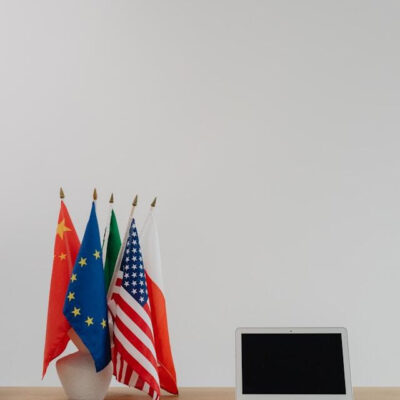
Is your business being affected by Trump Tariffs? We take a closer look at the US tariffs situation and how businesses can navigate the uncertainty.
On 2 April 2025, the dynamics of global trade shifted on an unprecedented scale.
President Trump’s administration announced Liberation Day – a sweeping overhaul of US trade policy, known colloquially as ‘Trump Tariffs’. The changes include introducing a universal 10% tariff on all imports to the country (other than from Mexico and Canada) as well as higher, country-specific reciprocal tariffs on approximately 60 nations.
The new reciprocal tariffs target countries viewed to have unfair trade practices. In other words, the nations deemed to have benefitted from decades of significantly lower US tariffs, allowing them to export items like cars, electronics, sportswear and toys into the country without the cost of higher rates.
At the same time US tariffs have been low, countries like China and Japan have implemented significant tariffs on imports. This imbalance made it virtually impossible for US businesses to enjoy similar commercial opportunities. The administration believes this has put the US at an unfair economic disadvantage, with onshore jobs moving offshore and opportunities curtailed for domestic industries – particularly around manufacturing.
The position of the Trump administration is that other countries are unfairly using tariffs and other protectionist measures to damage the US economy. The US imports a significant number of cars from Japan, for example, yet American vehicles face substantial challenges entering the Japanese market.
Trump Tariffs are a move to overturn this trade deficit and assert the US’s economic independence, reducing its reliance on foreign manufacturing and creating more opportunities for domestic businesses. They form part of a broader agenda of stimulating economic growth, economic nationalism and an effort to reshape international trade relationships.
The Business Impact of US Tariff Changes
At the time of writing, 70 nations are negotiating tariffs with the US – a significant number that highlights the current uncertainty over how significant the long-term impact will be.
The World Trade Organization (WTO) projects a 0.2% decline in global trade for 2025, with potential for it to rise to 1.5%. Meanwhile, North American exports and imports are expected to decrease by as much as 12.6% and 9.6% respectively.
The impact is already being felt by many businesses. But with negotiations ongoing and updates announced daily, the longer-term effects could be profound.
Many WatchMyCompetitor clients face big decisions to protect their businesses and revenues. So we wanted to discuss the different types of organisations that are being affected.
1. Non-US Businesses Exporting to the US
The businesses that sell into the US are likely to be the most affected by the changes, especially in the short-term. Their margins have been reduced significantly or, in some cases, obliterated overnight, leaving them in a challenging situation.
They’re faced with big strategic decisions to make. For some, they may look to pass on the costs to US consumers by charging more and protecting their margins. Others may be more focused on cost-cutting and tackling inefficiencies, possibly with the use of AI and other technologies.
Another route is to expand into new territories. Or, into markets they’re already in but have the potential to expand further. (More on that one shortly).
Another option for some may be to invest in new factories in the US – although the uncertainty caused by the ongoing nature of the tariff announcements means the timing of this decision will be key. No matter how badly they’ve been impacted so far, it’s not something businesses can rush through.
2. US Businesses Exporting or Importing
Businesses based in the US will theoretically have more domestic opportunities as a result of the tariff changes as overseas enterprises stop or pause exporting into the country. This has increased revenues overnight for some businesses as they seek to fulfil consumer needs. In time, this could create more employment opportunities for US people – a key motivation for the administration.
US businesses will however have to prepare for reciprocal tariffs that make it even more expensive to sell into other markets. As with the scenario of businesses exporting into the US, there are big decisions to be made regarding raising prices, cutting costs or pivoting into new markets.
Another consideration for US businesses will be their supply chain. Many import products or parts from countries like China and Japan in order to sell domestically. The increased tariffs will make this less feasible to do, leaving them with decisions over whether to use manufacturers within the US to avoid tariffs or again look at price rises and cost reductions.
As in all cases, increasing prices will have its own ramifications, potentially causing changes in consumer buying behaviour as they look for lower-cost alternatives.
3. Businesses Impacted By Changing Strategies
Businesses that import into and out of the US aren’t the only ones likely to be affected, though.
As we discussed above, one strategic move available to businesses directly affected is to move into new territories or expand operations in markets they’re already in. This could have huge implications on businesses that neither export or import into the US.
If Japanese car manufacturers, for example, can no longer afford to sell to the US, they may look to markets where tariffs are more workable as a way of maintaining car sales and overcoming the US shortfall.
For the businesses selling in those markets, this represents a new threat to their revenues and market share – especially if incoming businesses decide to offer discounts as a way to overcome the established competition.
Increasing Pressure on Decision-Making
For those affected, the next strategic decisions – and ability to adapt to ongoing changes – will have a huge impact on their futures, their consumers and the futures of other businesses.
Every day there are new updates from organisations like WTO, the White House and the international press. Negotiations are ongoing and creating further changes from those announced on Liberation Day. Financial, business and geopolitical experts are discussing every twist and turn in detail, offering insights in publications, blogs, the media and podcasts as to the reasons behind the changes and the potential consequences.
Then there’s the strategic and tactical responses of businesses in almost every industry. Even if they’re refraining from comment, many are making or preparing to make changes to protect their position and exploit opportunities. They may be holding fire on opening and shutting factories until things become clearer, but the signs of change are there. Whether it’s a shift in pricing, messaging or marketing focus.
For any business then, there lies uncertainty. And, with it, an increased pressure to make the right decisions and navigate the changing market and competitive landscapes. The right move can help them become more competitive and successful. It can force through innovations that create new opportunities across different markets and with different consumers.
On the flip side, the wrong approach could do the opposite. It could close off opportunities, reduce market share and even cause reputational damage.
All of this underscores the need to adapt to the US tariff changes by making smart, informed and well-timed decisions about their short- and long-term plans.
Get Informed and Adapt Effectively
This level of disruption to global trade means staying informed is difficult, but incredibly important.
Business leaders will make decisions using their knowledge and understanding of their industries and the implications of tariffs. So, having the most relevant and timely insights will be critical to making smart, strategic choices.
This is where market intelligence has a big role to play.
Market intelligence systematically collects and analyses data about competitors, markets, regulations and more. Even in fairly static markets, it helps businesses stay informed and make good decisions at the right times.
But in relation to the US tariffs, it can give them a huge advantage in being able to understand and interpret what’s happening in the US and other international markets.
Market intelligence can be used for:
Tracking Bilateral Trade Negotiations
The recent escalation between the US and China, with reciprocal tariffs reaching 125%, highlights the volatility of trade relations. Similarly, India’s proactive approach in initiating a 90-day roadmap for trade talks with the US. highlights the dynamic nature of international trade negotiations. By tracking this activity in real-time, you can anticipate changes and adjust your strategies accordingly.
Monitoring Communications from US Trade Authorities
Understanding the perspectives and decisions of key US trade officials can provide valuable insights into future policy directions. The 2025 Trade Policy Agenda, for example, outlines the administration’s focus on addressing non-reciprocal trading practices and reducing the trade deficit. By closely monitoring statements and reports from bodies like the Office of the United States Trade Representative, you can better prepare for upcoming changes and align your operations with evolving regulations.
Analysing Competitor Responses to Tariff Changes
Observing how competitors adapt to new tariffs can inform your own strategic decisions. Major retailers such as Target and Walmart have announced price increases in response to higher import costs. Automotive manufacturers like Ford and Volkswagen are also adjusting their pricing strategies to mitigate the impact of tariffs. While Jaguar Land Rover has announced it will no longer be shipping cars to the US. Whatever the responses in your industry are, by analysing them, you can identify effective tactics and avoid potential pitfalls in your adaptation strategies.
Tracking Established Businesses Entering Your Market
As we’ve discussed, one of the less obvious but still significant ways the tariffs will impact businesses is through new entrants into existing markets. There will be a ripple effect if businesses pivot into other markets to compensate for lost revenue in the US. Market intelligence can give you real-time data on new entrants by tracking changes to their marketing, messaging and investments. It can provide early indications of new threats, so you can take the right actions quickly to protect your positions.
Tracking New Competitors Entering the Market
Businesses that stand to benefit from non-US competitors halting their exports into the US may not have a clear run at the market. Opportunities will grow for new entrants – including start-ups and those expanding their offerings – if overseas businesses stop shipping into the US. As with other changes, market intelligence will spot these changes fast and give you the insights needed to evolve your strategies.
Identifying Cross-Industry and Cross-Territory Trends
Tariff changes can have ripple effects across various industries and regions. For example, the apparel industry is experiencing significant price increases, with projections indicating a 17% rise in clothing and textile prices due to tariffs. By identifying such trends, you can anticipate shifts in consumer behaviour and adjust your offerings to meet new demands. Even if you’re in non-related industries, there will be lessons to learn, such as how to navigate new competitors entering markets.
Leveraging Industry Analysis and Thought Leadership
Engaging with industry analyses and expert commentaries can deepen your understanding of the broader implications of tariff changes. Reports from institutions like the Yale Budget Lab provide insights into the economic impact of tariffs, such as the projected 1.1% reduction in GDP. Staying informed through such resources enables businesses to make data-driven decisions and develop resilient strategies.
–
So, by gathering and using market intelligence, your business can navigate the complexities of the current trade environment more effectively. You can feel more confident about the options available and the decisions you decide to make. You can protect your revenues and safeguard the future of your business.
To learn more about market intelligence and the role it can play, visit watchmycompetitor.com.




